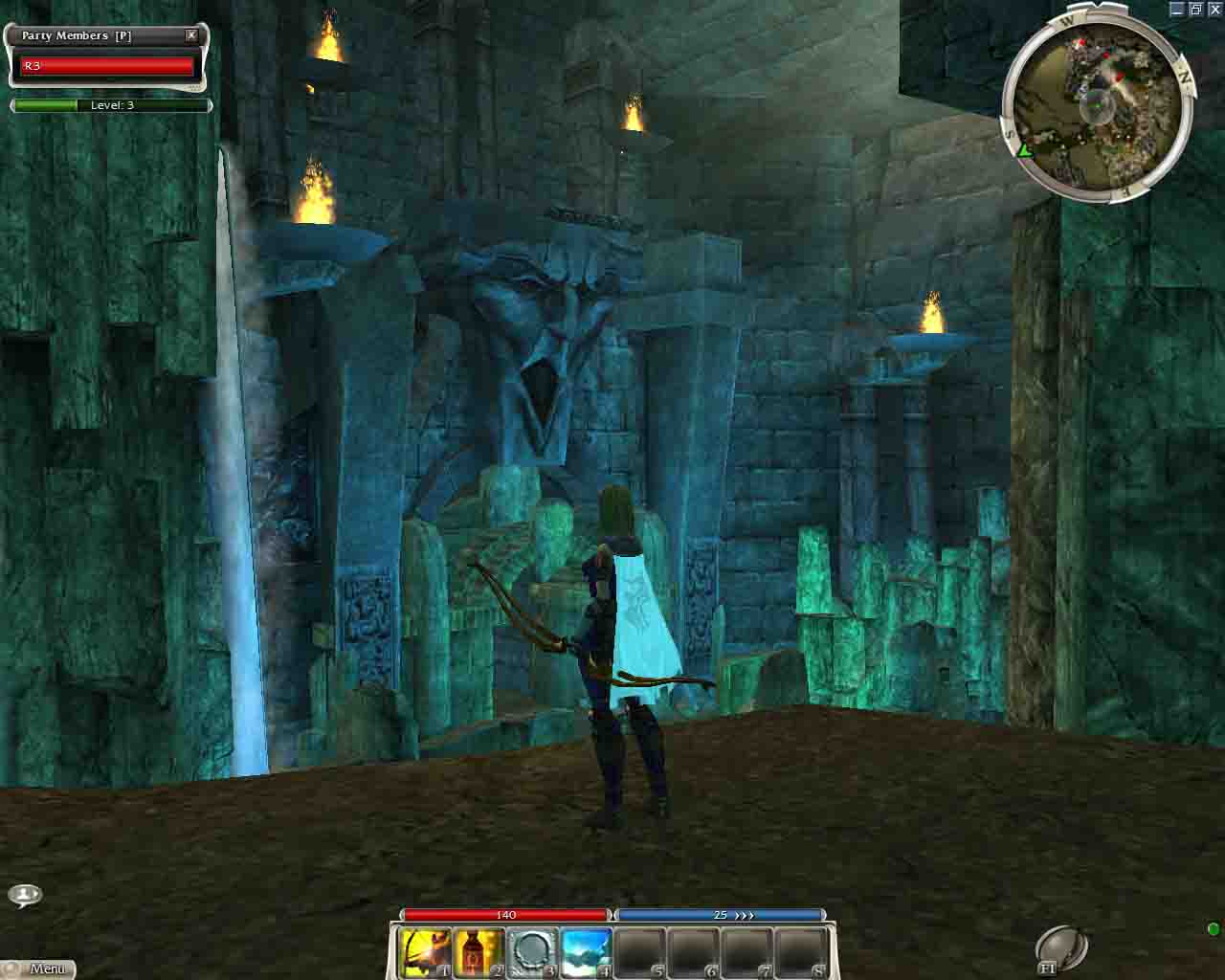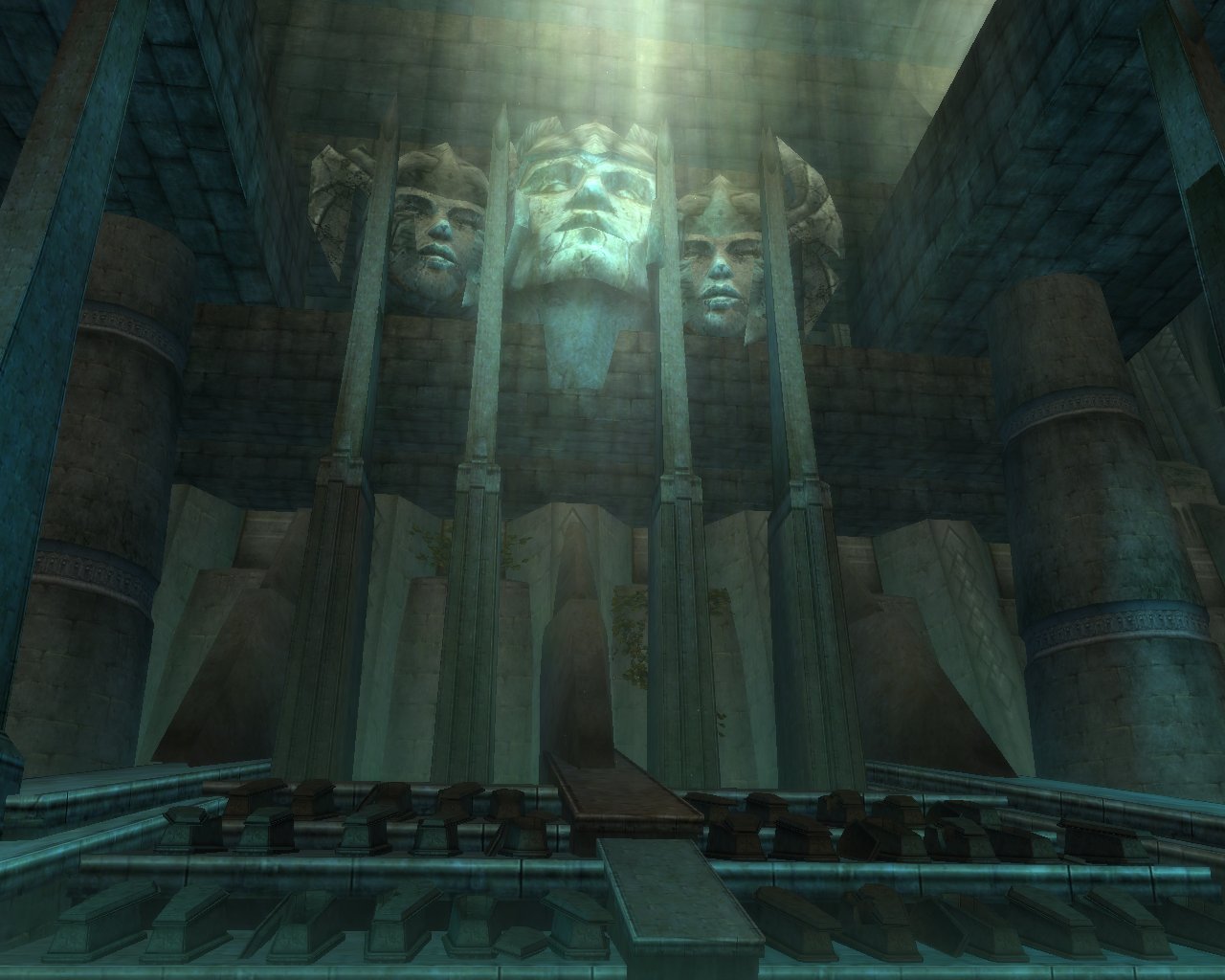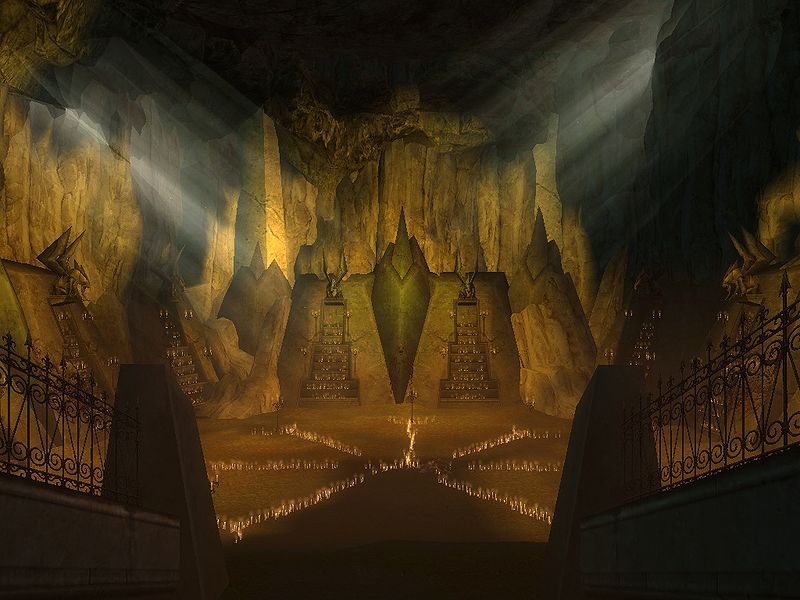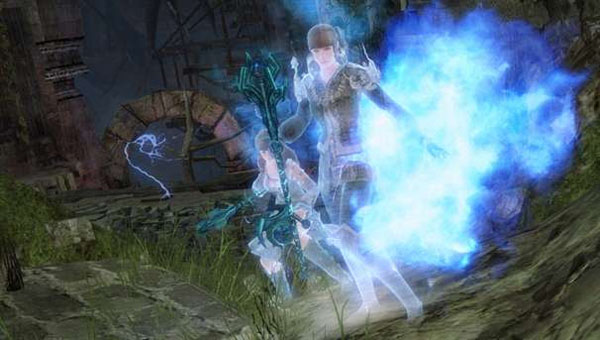L
O
R
E
The Catacombs is a mysterious underground network of various structures, halls, chambers, and natural caverns below much of central Ascalon. Given the short time our Ascalonian characters could spend in their then beautiful country, we were unable to learn much about the many secrets the Catacombs hold: origins, date of creation, the builders, the purpose of the structures and rooms, the reason why it became neglected and abandoned, etc.
After the Searing, the characters were completely cut off from the Catacombs, thus our small knowledge of the area comes from that one bright day when Ascalon burned.
 For many people, possibly the first steps in the Catacombs happened during their primary, or secondary profession training – or they were simply curious, accepted a later quest that took them to the underground complex, wanted to trade in some collectibles for better armor pieces, or had some completely different reason.
For many people, possibly the first steps in the Catacombs happened during their primary, or secondary profession training – or they were simply curious, accepted a later quest that took them to the underground complex, wanted to trade in some collectibles for better armor pieces, or had some completely different reason.
So, focusing on the monk training quest and another side-quest given by Mistress Munne, there are a few things that we can discover early on: the corridors closest to Ashford Abbey contained the buried remains of Ascalonian soldiers who had given their lives protecting their nation from Orrian and Krytan guilds, and of course from the charr in the north. The other one is that the Catacombs held (and hopefully still hold) mysterious artefacts – it might be a surprise as the more adventurous (grave) robbers could’ve easily stolen the more valuable relics by 1072 AE.
From further quests it also turns out that its dark halls offered refuge to unsavoury characters (mostly undead) who either went there hiding (Kasha’s formerly living, turned undead students, the Blood Fanatics) or people who liked to be left alone and lived in the shadows, like Oberan the Reviled.
My well educated colleague, Artaxerxes, will speak more of the mysteries of the style the architecture here; however, I would like to introduce some rooms of the Catacombs – it could come in handy sooner or later...
Due to the great number of Grenth statues within the Catacombs it can be said that it was devoted to the God of Death from the very beginning or at least after the Ascalonians had settled down on the high plain after pushing the charr back to their northern homelands. Only one mural of Dwayna was visible to the players, watching over the restless, ghostly warriors I mentioned earlier. And even then, the beautiful winged goddess was sternly watched by the cold eyes of one of Grenth’s statues, rising above his mortal subjects in a nearby, dark corner.
This chamber in the northeastern corner of the explorable region of the Catacombs is the most interesting to me. The hall there contained hundreds of coffins, guarded by stone gargoyles perched on the pillars and columns. But the most enigmatic feature was the three stone heads of heroes (two females and one male) looking down upon the characters from the far end of the room, illuminated by the sunlight. Who were these heroes? Do they have any connection to the similarly carved gigantic stone statues buried and crumbling in the crystalline sand of the Crystal Desert? My lorehound self demands answers from Guild Wars 2, and I can only hope he will be satisfied.

Addendum: This paragraph was written before gamescom, when we didn't know about Duke Barradin's soul possessing a very similar statue (this time a bust with arms though, instead of the heads) in his family's vault in the charr tutorial area. At a Lore Q&A panel with Ree Soesbee and John Ryan it turned out the statue the duke takes control of is an ancestral statue of his family - meaning that the other stone sculptures in the area are probably depicting the ancestors of Ascalonian noble families. Still, the questions in the previous paragraphs are still worthy of acquiring answers to them.
Then there was the large pit area in the western, northwestern part of the explorable Catacombs. The room itself was circular with a giant hole in the middle, which was so deep that the bottom of it could not have been seen in the light-poor environment. The pit was also "watched over" by the same gargoyles of legend I spoke of previously, equally divided around the "well." An unwary adventurer could've easily found him or herself in trouble here, as the undead amassed near this pit in great numbers. Oberan the Reviled also lurked in this chamber, claiming that this way "he would be away from the prying eyes of the living." Maybe he was behind the unusual amount of undead in the area after all, no? Unfortunately, we will never know, because he got killed by some Ascalonian younglings after he had gone insane and started harassing farmers with his undead servants.
 And last but not least, the ritual chamber. Another dangerous place it was, especially for the victims (like Farmer Pitney’s Prize Moa Bird) of those who were offered as sacrifices to nightmares from beyond. Take a good look at the past look of this place... something tells me it’s not the last time we’ve seen it.
And last but not least, the ritual chamber. Another dangerous place it was, especially for the victims (like Farmer Pitney’s Prize Moa Bird) of those who were offered as sacrifices to nightmares from beyond. Take a good look at the past look of this place... something tells me it’s not the last time we’ve seen it.
Wait a second! One of the key features was almost forgotten. The first Giganticus Lupicus skeletons the players and their characters ever set their eyes on – which can be easily missed. Remember the old days? When you read the Manuscripts and stumbled upon the first entry in the Timeline: 10,000 BE - Last of the Giganticus Lupicus, the Great Giants, disappear from the Tyrian continent. You thought it was a nice little tidbit about the lore of Tyria, and a bit later you threw yourself into Guild Wars for the first time, busting skales in the beautiful Lakeside County, forgetting this eerie date and the event connected to it. More than 2 years later their name was spoken again, but the context was different… the Elder Dragons, the greatest threat Tyria has ever seen is somehow connected to them. Maybe they were the prey, or just simple nemeses of the great dragons, but those primordial entities have been here around the time when the Giants disappeared from the world. It might not have meant much in 2005, but now that place has a significance... at least for lore-lovers, though I hope I’m not wrong when I say that non-hardcore lore people is be intrigued as well.
Then again, there is another interesting thought that emerged with the release of the Bonus Mission Pack. The mission called the Flight North – that deals with how Gwen escaped from her charr slavers seven years after the Searing – takes place up in the north, where the northern Blazeridge Mountains connect into the Northern Shiverpeaks. These lands had once belonged to Duke Gaban, before the charr started the invasion into human lands. However, the real food for thought here is another underground complex that holds large murals of a warrior scholar and research of a wise and brave mesmer who devised many spells to hinder the invading charr hordes. The villagers and the townsfolk who the unknown mesmer belonged to made their last stand in this underground complex. His last entry is really touching:
It is entirely possible that this northern entrance is also connected - through some unseen tunnels or passages - to the “main body” in central Ascalon, which puts things into a new perspective regarding origins of the whole complex. On the other hand, it still doesn't mean that the vast majority of the chambers and structures in the Catacombs were not hewn out and into a natural cavern system. Even then, the origins of a cavern that spans an entire basin between two large mountain ridges is still very intriguing. What kind of natural processes created it? Or was it the result of an artificial (read: magical) phenomenon? Say, like a cataclysm similar to the one caused by Abaddon's defeat?“The Charr have come to us. All I can do is try to save my research in the hope that someone can use it to forge a better future for mankind. It was this overwhelming desire to stem the tide that inspired my last spell. I have found a way to use the ether to directly inhibit a foe's mind. The weave is complex, but when properly crafted the spell slows a foe's actions. It is as if he is moving through molasses. If only this could slow the wave of inevitability about to wash over us. Perhaps some might escape...”
Right, I’m not going into the details (see Mr Jeff Grubb’s & Mr Matt Forbeck’s Ghosts of Ascalon for that), but the gist of the events relating to the current state of the Catacombs (wait... why I’m even writing this? If you didn’t know about the next few lines after the parentheses, I must ask you this: where on Tyria have you been in the last couple of months?): King Adelbern went completely nuts, and set off the Foefire: another magical nuke on the day when the charr were about to conquer Ascalon City. However, instead of gigantic purple crystals impacting into the ground, the magical blast incinerated the charr besiegers of the city, but went much further in affecting the humans inside Ascalon’s borders. Every man, woman, and child died, then returned as vengeful ghosts trapped in time – reliving the day of the Foefire again and again, strongly believing that the charr are at the gates and they could begin the siege at any moment.
During the epic story of our heroes, we get to visit the Catacombs at level 30. Eir, norness sculptor and co-founder of the legendary Destiny’s Edge, wants to recover the weapon that held (and possibly still holds) the power of Foefire. Actually, this sword, Magdaer, originates from Orr, when the human gods walked amongst the mortals of the land, thus it is possible it was crafted or enchanted by one or more members of the Six. The sword’s sister is Sohothin, the late Prince Rurik’s sword, which is now wielded by Rytlock Brimstone – at least he and his buddy, Logan, claim that it is actually Sohothin, and not just an "ordinary" Fiery Dragon Sword. So, Eir goes on her foolhardy mission right into the Catacombs, but Tribune Brimstone is worried that people could get hurt and wants to stop the norn before the whole Ascalonian spectral army awakens and begins slaughtering everything that Adelbern’s hatred compels them to do so. Rytlock sends for reinforcements, and our heroes answer his call. We are greeted with a few disparaging words and a similar introductory speech – that is, of course, more awesome due to Steve Blum’s (Rytlock’s voice actor) amazing narrative and the gorgeous concept art cinematic that’s guaranteed to give you goosebumps. (I actually started jumping on my chair when I first saw the sequence Foefire’s blast and curse in the sequence... nerds these days.) And after that we finally take our first steps in the Catacombs after more than 250 years...
Inside we will fight spirits of the now-non-existant monk girls (using the updated Ray of Judgement), elusive mesmers, spectral elementalist nuking the hell out of you if you’re not careful, and many-many more ghost warriors and rangers (in the released footage, I haven’t seen ordinary ghost necromancers so far). Of course, the bosses can’t be missing from such an epic, nostalgic endeavour, so the restless souls of our Ascalonian GW1 trainers are going to try to stop us from reaching their mad king: Necromancer Munne, Ralena Stormbringer & Vassar (the lovers), and Master Ranger Nente. After the heroes have fought their way through the many chambers I detailed in the first section, Adelbern finally appears for a big showdown. If you defeat the last king of Ascalon, you get a token that you can turn in for a Ghastly weapon (see last year’s Gamescom demo), and go on your way that will take you to Arah in the end. Well, surely, you’ll get there sometime, but don’t think that the situation in the Catacombs is stabilized. Far from it...
By weakening the ghosts, an unnatural darkness (the gravelings – I can imagine them to be quite reminiscent to the Behemoth Gravebanes from Elona, just a bit smaller) is trying to take over the area. Add the fact that they feed on ghosts, and you'll see that this doesn’t bode well for anyone. So, Durmand Priory sends three people to deal with the problem: a charr, a human, and an asura. Each of them proposes a different method to solve the graveling menace, and each method offers a fundamentally different approach and experience at how you and your group will do the exploration mode.
 The main objective is to kill the graveling patriarch. The asura's (Tzark) plan involves essence collectors being set up in the Lover's Crypt (the place where Vassar and Ralena can be together in death) for the obvious reason, in my opinion, to collect enough ghastly essence/residue from the area that even the patriarch (who probably only goes for the truly delicious and powerful spirits) won't be able to resist the temptation of a - seemingly - easy meal. Which will result in his inevitable death, as Tzark will probably stop at nothing to accomplish the task - yes, that may include your life, fellow adventurer, so I strongly suggest keeping an eye on the little guy.
The main objective is to kill the graveling patriarch. The asura's (Tzark) plan involves essence collectors being set up in the Lover's Crypt (the place where Vassar and Ralena can be together in death) for the obvious reason, in my opinion, to collect enough ghastly essence/residue from the area that even the patriarch (who probably only goes for the truly delicious and powerful spirits) won't be able to resist the temptation of a - seemingly - easy meal. Which will result in his inevitable death, as Tzark will probably stop at nothing to accomplish the task - yes, that may include your life, fellow adventurer, so I strongly suggest keeping an eye on the little guy.
The other plan is about making the proposer and the group look completely ghostly (don't ask me how), and tricking Warmaster Grast's ghost and those of his fellow soldiers into assaulting the patriarch. If I had to bet, I'd say it's the plan of the human "Priorite." Only we can be so sly and deceitful.
Unfortunately, I don't know plan #3, and this will probably be the case until the long-awaited and almost heavenly moment of this unearthly brilliant game's release arrives and passes away - you got to give me a day or two to get to the Catacombs from level 1.
Well, that was my silly summary of the currently known lore of the Catacombs. Since I became sentimental from writing the previous paragraph, all I can say is that I yearn to share more information about this ancient place that tears at our soul as we think back of the good old days when we took our first steps in Pre-Searing Ascalon.